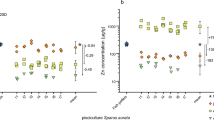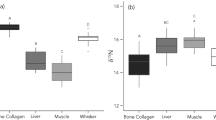Abstract
This study investigated the trophic hierarchy status of the Antarctic petrel (Thalassoica antarctica) and snow petrel (Pagodroma nivea) within the Southern Ocean food-web off Dronning Maud Land, Antarctica. During 1991/92 ten Antarctic petrel and ten snow petrel carcasses were collected from Jekselen (71°59′S, 02°35′W) and Robertskollen (71°28′S, 03°15′W) respectively, in the northern Ahlmannryggen, Dronning Maud Land. Collagen from the dense bone of the humeri of these carcasses was extracted and the stable carbon and nitrogen isotope ratios of these samples determined. The snow petrel bone collagen samples displayed a mean δ13C value of −23.9±0.7 (range: −24.7 to −22.9; n=9) and a mean δ15N value of 15.2±1.6 (range: 12.9 to 18.4; n=10). The corresponding values for Antarctic petrel bone collagen were −24.8±1.0 (range: −26.2 to −22.8; n=9) and 13.2±0.6 (range: 12.5 to 13.9; n=8) respectively. The difference between the species’ δ13C values may indicate differences in their foraging habitat. It has previously been suggested that the snow petrel has a higher wing loading than other Procellariiforme species, making the snow petrel less adapted to pelagic foraging than related species and more likely to forage close to the sea ice edge. Algae growing under sea ice apparently can have comparatively high δ13C values, possibly due to growing under carbon dioxide limited conditions. If so, animals foraging close to the sea ice edge might be expected to show higher δ13C values in their body tissues than animals foraging farther out over the open ocean. However, the high δ13C of snow petrel collagen is possibly more likely to be related to the correspondingly high δ15N values found in this tissue, and hence caused by snow petrels including offal from high trophic level Antarctic mammals and birds in their diet.


Similar content being viewed by others
References
Ainley DG, O’Connor EF, Boekelheide RJ (1984) The marine ecology of birds in the Ross Sea, Antarctica. AOU Ornithol Monogr 32:1–97
Baroni C, Belluomini G, Branca ME, Improta S, Orombelli G (1991) Radiocarbon dates from Terra Nova Bay (Victoria Land, Antarctica): conventional and calibrated ages. Mem Soc Geol Ital 46:81–92
Bligh EG, Dyer WJ (1959) A rapid method of total lipid extraction and purification. Can J Biochem Physiol 37:911–917
Broecker WS, Olson EA (1961) Lamont radiocarbon measurements VIII. Radiocarbon 3:176–204
Brown DA (1966) Breeding biology of the Snow Petrel Pagodroma nivea (Forster). ANARE Sci Rep Series B 89:1–63
Chisholm CS, Nelson DE, Schwarcz HP (1982) Stable carbon isotope ratios as a measure of marine versus terrestrial protein in ancient diets. Science 216:1131–1132
DeNiro MJ, Epstein S (1978) Influence of diet on the distribution of carbon isotopes in animals. Geochim Cosmochim Acta 42:495–506
DeNiro MJ, Epstein S (1981) Influence of diet on the distribution of nitrogen isotopes in animals. Geochim Cosmochim Acta 45:341–351
Duffy DC, Jackson S (1986) Diet studies of seabirds: a review of methods. Colon Waterbirds 9:1–17
Eadie BJ, Jeffrey LM (1973) δ13C analyses of oceanic particulate organic matter. Mar Chem 1:199–209
Gould P, Ostrom P, Walker W (1997) Food of Flesh-footed Shearwaters Puffinus carneipes associated with high-seas driftnets in the central North Pacific Ocean. Emu 97:168–173
Griffiths AM (1983) Factors affecting the distribution of the Snow Petrel (Pagodroma nivea) and the Antarctic Petrel (Thalassoica antarctica). Ardea 71:145–150
Harkness DD (1979) Radiocarbon dates from Antarctica. Brit Antarct Surv Bull 47:43–59
Harper PC (1987) Feeding behaviour and other notes on 20 species of Procellariiformes at sea. Notornis 34:169–192
Hiller A, Wand U, Kämpf H, Stackebrandt W (1988) Occupation of the Antarctic continent by petrels during the past 35000 years: inferences from a 14C study of stomach oil deposits. Polar Biol 9:69–77
Hiller A, Hermichen W-D, Wand U (1995) Radiocarbon-dated subfossil stomach oil deposits from petrel nesting sites: novel palaeoenvironmental records from continental Antarctica. Radiocarbon 37:171–180
Hobson KA (1987) Use of stable-carbon isotope analysis to estimate marine and terrestrial protein content in gull diets. Can J Zool 65:1210–1213
Hobson KA (1993) Trophic relationships among high Arctic seabirds: insights from tissue-dependent stable-isotope models. Mar Ecol Progr Ser 95:7–18
Hobson KA, Clark RG (1992) Assessing avian diets using stable isotopes I: turnover of 13C in tissues. Condor 94:181–188
Hodum PJ, Hobson KA (2000) Trophic relationships among Antarctic fulmarine petrels: insights into dietary overlap and chick provisioning strategies inferred from stable-isotope (δ15N and δ13C) analyses. Mar Ecol Progr Ser 198:273–281
Jackson S, Duffy DC, Jenkins JFG (1987) Gastric digestion in marine vertebrate predators: in vitro standards. Funct Ecol 1:287–291
Lee-Thorp JA, Sealy JC, van der Merwe NJ (1989) Stable carbon isotope ratio differences between bone collagen and bone appatite, and their relationships to diet. J Archaeol Sci 16:585–599
Linick TW (1977) La Jolla natural radiocarbon measurements VII. Radiocarbon 19:19–48
Marchant S, Higgins PJ (1990) Handbook of Australian, New Zealand and Antarctic Birds. Volume I: Ratites to Ducks. Oxford University Press, Melbourne
McConnaughey T, McRoy CP (1979) Food-web structure and the fractionation of carbon isotopes in the Bering Sea. Mar Biol 53:257–262
Michener RH, Schell DM (1994) Stable isotope ratios as tracers in marine aquatic food webs. In: Lajtha K, Michener RH (eds) Stable Isotopes in Ecology and Environmental Science, Blackwell Scientific, Oxford 138–157
Mizutani H, Wada E (1988) Nitrogen and carbon isotope rates in seabird rookeries and their ecological implications. Ecology 69:340–349
Mizutani H, Fukuda M, Kabaya Y (1990) Carbon isotope ratio of feathers reveals feeding behaviour of cormorants. Auk 107:400–403
Mizutani H, Kabaya Y, Wada E (1991) Nitrogen and carbon compositions relate linearly in cormorant tissues and its diet. Isotopenpraxis 27:166–168
Mougin J-L (1968) Etude ecologique de quatre especes de petrels Antarctiques. Oiseau 38:1–51
Nichols PD, Klumpp DW, Johns RB (1985) A study of food chains in seagrass communities III. stable carbon isotope ratios. Aust J Mar Freshw Res 36:683–690
Peterson BJ, Fry B (1987) Stable isotopes in ecosystem studies. Ann Rev Ecol Syst 18:293–320
Rau GH, Mearns AJ, Young DR, Olson RJ, Schafer HA, Kaplan IR (1983) Animal 13C/12C correlates with trophic food level in pelagic food webs. Ecology 64:1314–1318
Ridoux V, Offredo C (1989) The diets of five summer breeding seabirds in Adélie Land, Antarctica. Polar Biol 9:137–146
Ryan PG, Steele WK, Siegfried WR, Vogel JC (1992) Radiocarbon dates of Snow Petrel regurgitations can reveal exposure periods for nunataks in Antarctica. S Afr J Sci 88:578–580
Sackett WM, Eckelmann WR, Bender ML, Bé AWH (1965) Temperature dependence of carbon isotope composition in marine plankton and sediments. Science 148:235–237
Schmidt K, Atkinson A, Stübing D, McClelland JW, Montoya JP, Voss M (2003) Trophic relationships among Southern Ocean copepods and krill: some uses and limitations of a stable isotope approach. Limnol Oceanogr 48:277–289
Sealy JC (1986) Stable carbon isotope and prehistoric diets in the south-western Cape Province, South Africa. Brit Archaeol Rep Int Ser 293:1–150
Steele WK, Hiller A (1997) Radiocarbon dates of Snow Petrel nest-sites in central Dronning Maud Land, Antarctica. Polar Rec 184:29–38
Steele WK, Hockey PAR (1991) The human influence on Kelp Gull diet assessed using stable carbon isotope analysis of bone collagen. S Afr J Sci 87:273–275
Sydeman WJ, Hobson KA, Pyle P, McLaren EB (1997) Trophic relationships among seabirds in central California: combined stable isotope and conventional dietary approach. Condor 99:327–336
Thompson DR, Lilliendahl K, Solmundsson J, Furness RW, Waldron S, Phillips RA (1999) Trophic relationships among six species of Icelandic seabirds as determined through stable isotope analysis. Condor 101:898–903
van Franeker JA (2001) Mirrors in ice: fulmarine petrels and antarctic ecosystems. PhD Thesis, University of Groningen, Netherlands
Wada E, Terazaki M, Kabaya Y, Nemoto T (1987) 15N and 13C abundances in the Antarctic Ocean with emphasis on the biogeochemical structure of the food web. Deep Sea Res 34:829–841
Whitehouse IE, Chinn TJH, Höfle HC, McSaveney MJ (1988) Radiocarbon contaminated penguin bones from Terra Nova Bay, Antarctica. NZ Antarct Rec 8:11–23
Wilson RP (1984) An improved stomach pump for penguins and other seabirds. J Field Ornithol 55:109–112
Acknowledgements
I thank John Lanham and Julie Lee-Thorp of the Archaeometry Laboratory, University of Cape Town, for their patient instruction and advice. I also thank Marthé Mokone for assistance in the laboratory, and Dr Norbert Klages of the Port Elizabeth Museum for the identification of prey species. The suggestions of Dr. J. A. van Franeker and two anonymous referees served to improve this paper and they are thanked for their advice. Financial and logistic support for research in Dronning Maud Land provided by the former South African Department of Environmental Affairs and Tourism through the South African Committee on Antarctic Research is gratefully acknowledged.
Author information
Authors and Affiliations
Corresponding author
Rights and permissions
About this article
Cite this article
Steele, W.K. Stable isotope ratios of Antarctic petrel (Thalassoica antarctica) and snow petrel (Pagodroma nivea) bone collagen. Polar Biol 28, 672–679 (2005). https://doi.org/10.1007/s00300-005-0736-3
Received:
Revised:
Accepted:
Published:
Issue Date:
DOI: https://doi.org/10.1007/s00300-005-0736-3




